7 Endangered Penguin Species
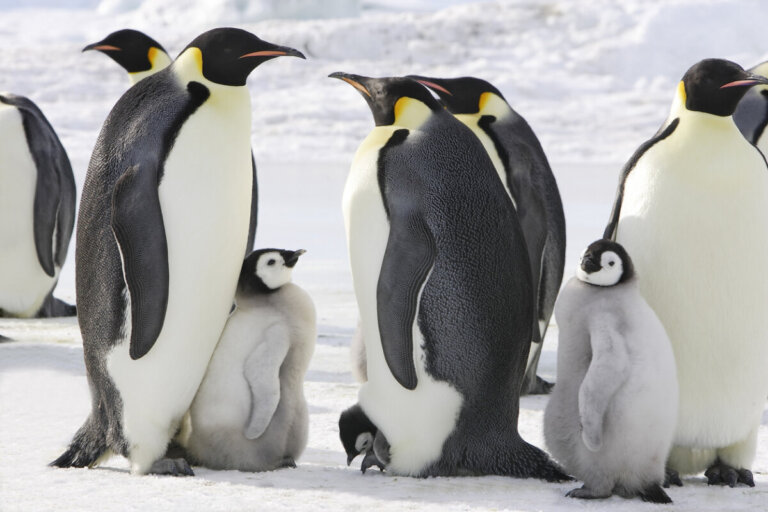

Written and verified by the biologist Georgelin Espinoza Medina
Sphenisciformes are emblematic birds distributed in the southern hemisphere. Their wings have been transformed into flippers, so they don’t fly but, rather, they’re adapted to swim and do so excellently. What’s more, their webbed feet help them move around the water very well. But did you know that there are many endangered penguin species?
There are about 19 species worldwide, and more than half of them are threatened by different causes, among them, climate change is the main one. In these lines, we’ll share with you a list of species at risk of extinction, a brief description of each one, and the reasons for their conservation status. Don’t miss it!
Why are there endangered penguin species?
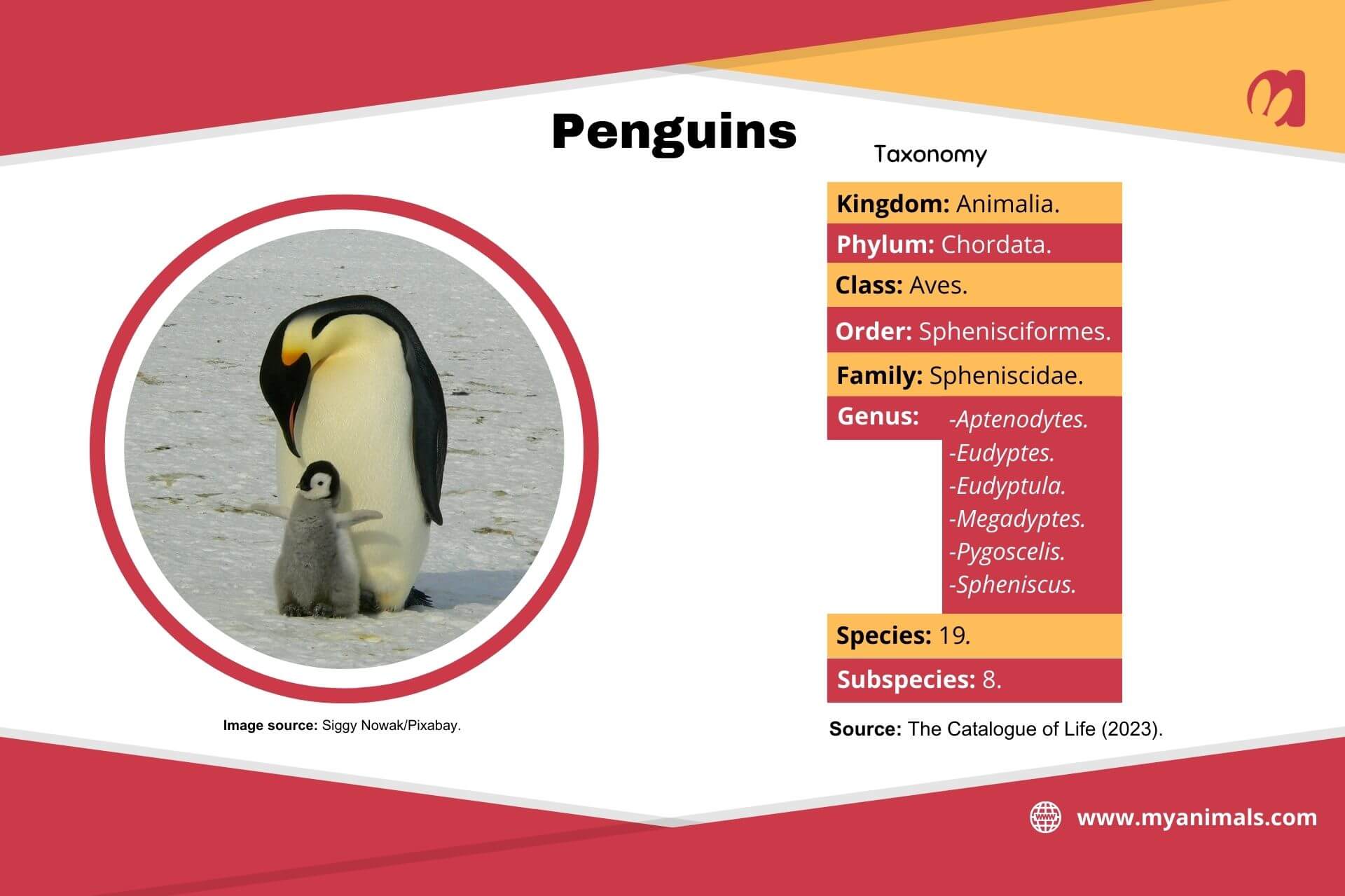
Penguins are threatened by various causes. Almost all species are affected by climate change. This phenomenon has an impact on several key aspects:
- Changes in food availability and abundance.
- Interference in the reproductive success of populations.
- Extension of the sea ice cover (in the last decades, it has decreased).
However, this isn’t the only existing cause. In this regard, we can mention others, such as the following:
- Pollution
- Human disturbances
- Fishing and harvesting of aquatic resources
- Diseases and introduction of new species
Which penguin species are endangered?
According to reports from the International Union for Conservation of Nature (IUCN), nine penguin species are at risk: Five are in the “endangered” category, and four are in the “vulnerable” category. Likewise, two specimens are “near threatened.” Now, let’s get to know some of those that appear in the following list.
1. Southern rockhopper penguin (Eudyptes chrysocome)
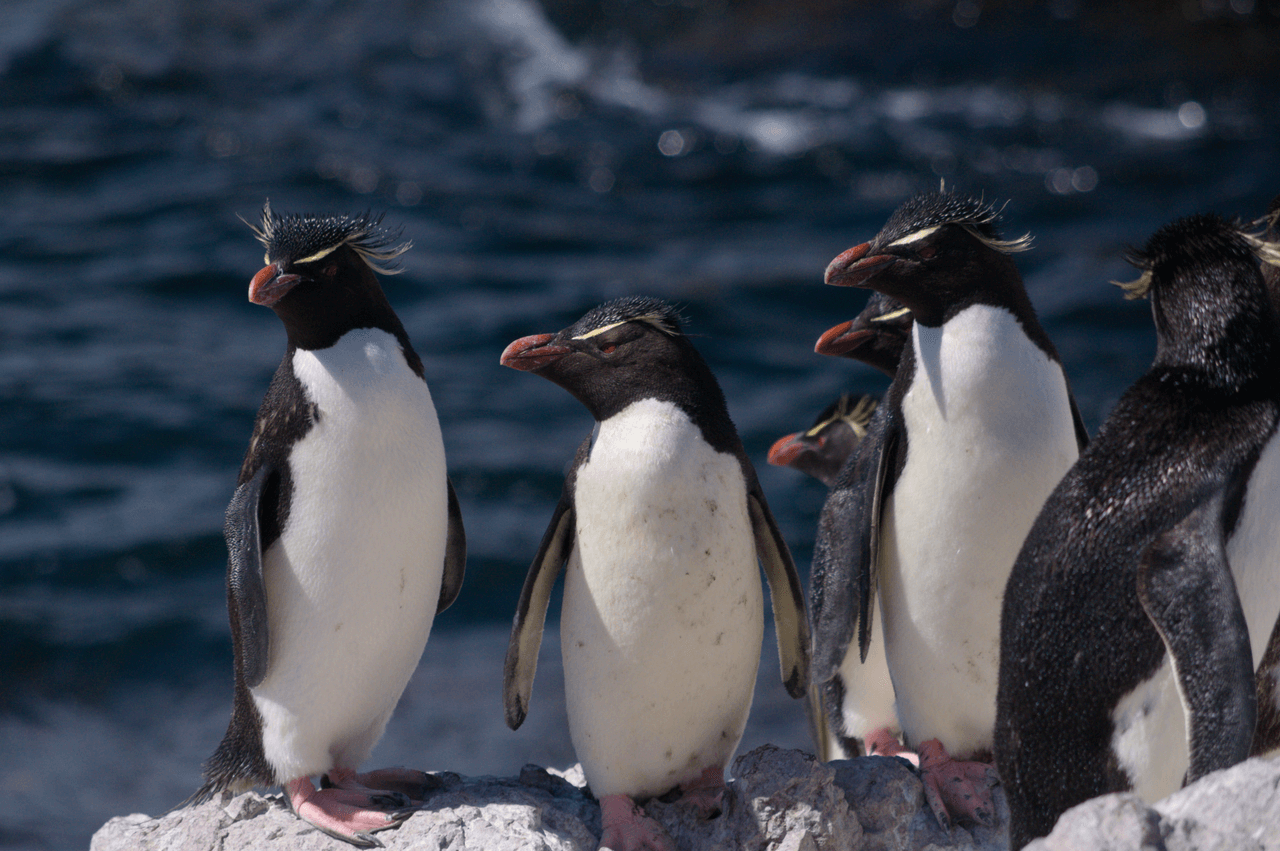
The southern rockhopper penguin a robust species, which can reach 21.5 inches in length and about 7.5 pounds in weight. It has white underparts, while the upper parts are slate gray or bluish-black.
It has a bright yellow coloration on the forehead, which extends like a feather on the sides of the head.
It’s been listed as “vulnerable,” according to IUCN reports, since 2008. This is due to the decline of its populations in the past and continuing in recent decades. Threats are varied. The following is a list of the most important ones:
- Fishing.
- Tourism.
- Diseases.
- Land management.
- Oil spills.
- Climate change (as it’s sensitive to ocean temperatures, which affect reproduction and food resources).
2. Macaroni penguin (Eudyptes chrysolophus)

The macaroni species is a large species, measuring 28 inches in length and 11 to 13 pounds in body mass. It has a black coloration on the upper part and white on the lower part. In addition, it has a red beak.
It has crests with the following colors, which are unified in the upper part of the head:
- Black
- Yellow
- Orange
It lives in large colonies of up to 2.5 million individuals, according to the Animal Diversity Web. It’s a sub-Antarctic bird and has been listed as “vulnerable” by the IUCN since 2000 due to various threats. It’s estimated that climate change alters its habitat and affects its reproductive success. It’s also affected by other dangers:
- Fishing
- Diseases
- Pollution
3. Snares penguin (Eudyptes robustus)
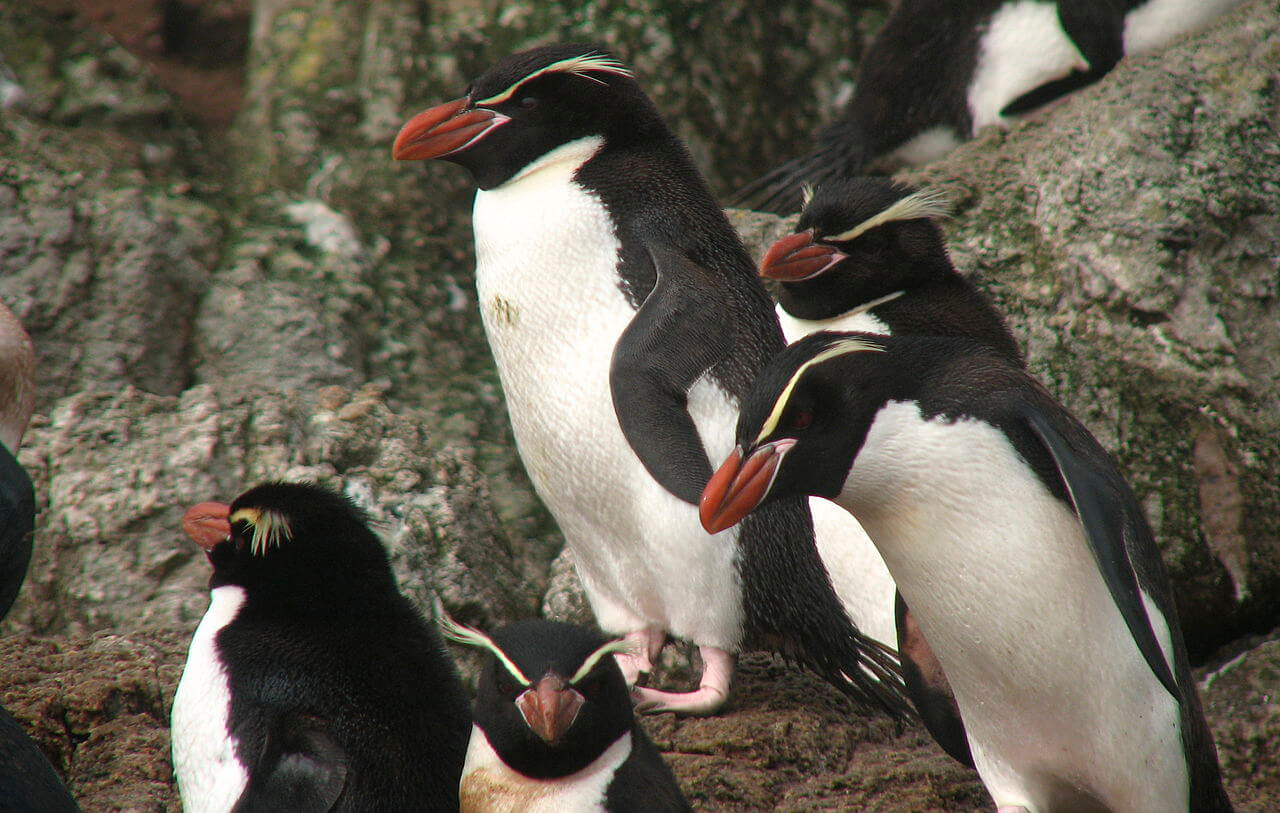
This is one of the endangered medium-sized penguins, which can reach an average length of 23.5 inches. Its appearance is similar to that of other Sphenisciformes, with a white ventral region and a dark dorsal region in a blue or black tone.
Among its characteristics, the yellow crest above the eyes stands out. It also has a reddish brown beak, but with a light pink base. This feature differentiates it from its Fiordland penguin (Eudyptes pachyrhynchus).
Its location is restricted to a small group of sub-Antarctic islands, south of New Zealand, the Snares (hence its name). Because of this limited location, they have been listed as “vulnerable” on the IUCN Red List since 1994. In addition, they’re sensitive to the following factors:
- Commercial fishing
- Human activities
- Oil spills
- Oceanographic changes
However, the population remains stable. So says a study published in the New Zealand Journal of Ecology in which the nests of this species were counted over several years (2008, 2010, and 2013).
4. Galapagos penguin (Spheniscus mendiculus)
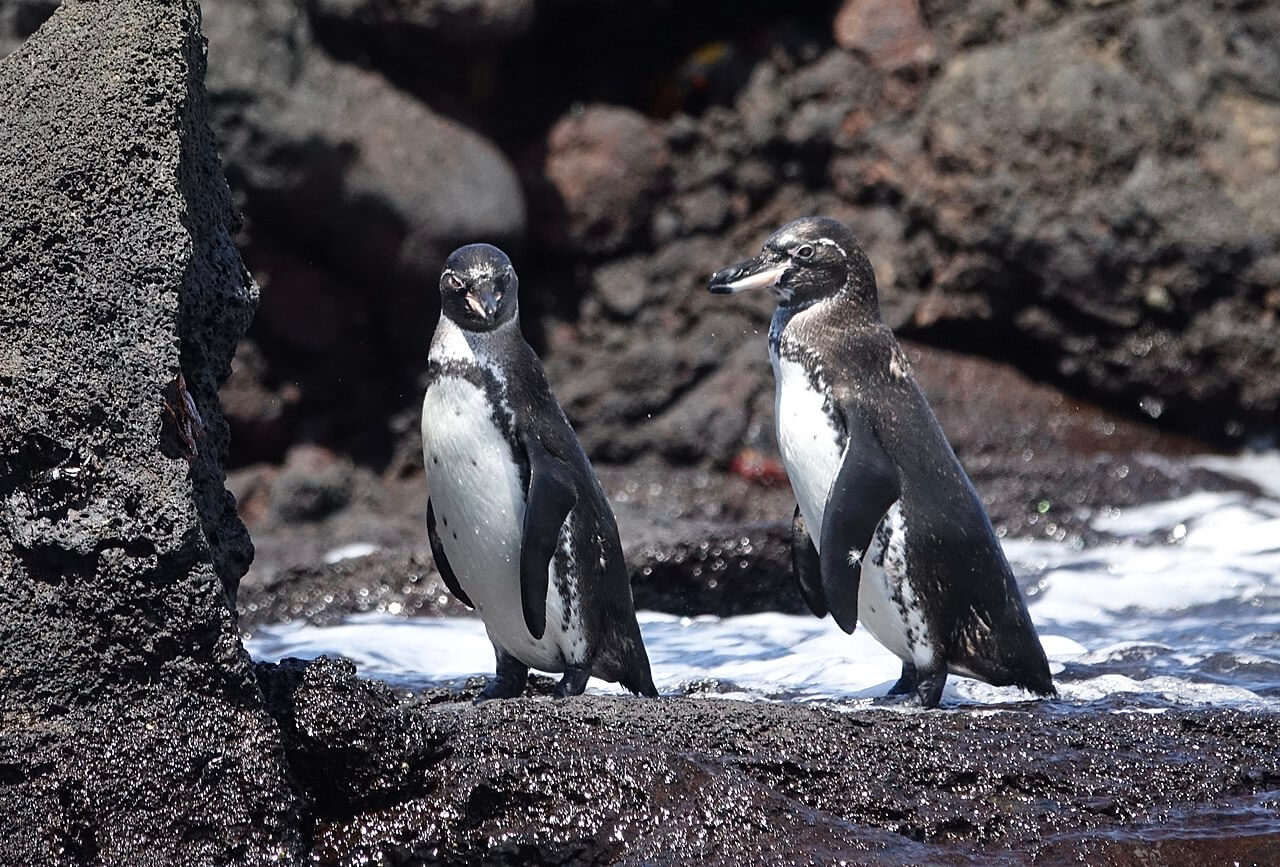
The Galapagos penguin is a small penguin. In fact, it’s the tiniest member of its genus, reaching 21 inches and weighing 4.4–8.8 lbs. Most of its body is black, although it also has white areas, such as the frontal area.
Its common name refers to its location, as it’s found in the Galapagos Islands. This penguin species has been listed as endangered since 2000 and is threatened by several causes:
- Pollution
- Human disturbance
- Predation by non-native animals
- Climate change and El Niño phenomenon (which causes variations in the food supply)
5. Humboldt penguin (Spheniscus humboldti)
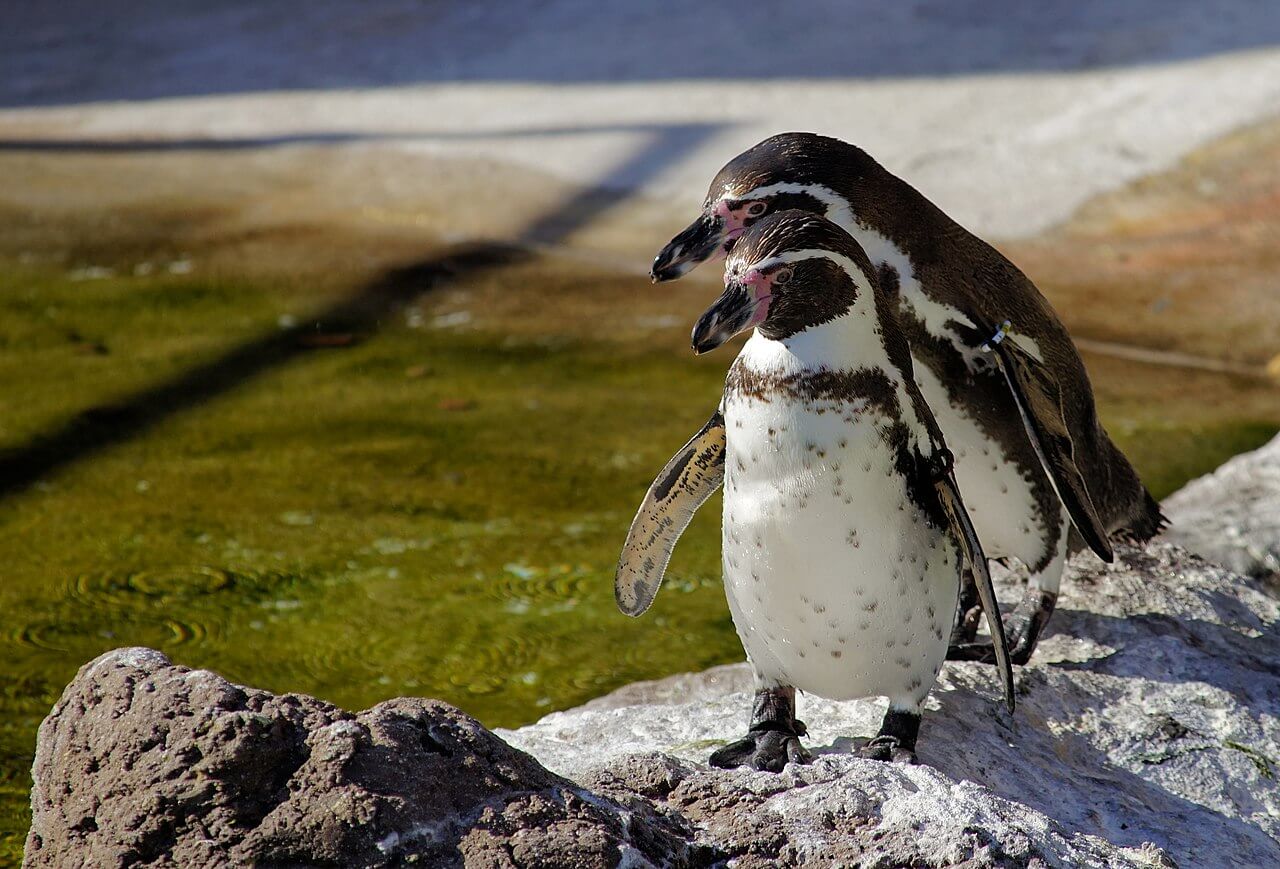
The Humboldt penguin is a bird that measures between 22–28 inches. It’s found from Foca Island (Peru) to Guafo Island (Chile). It has a blackish gray coloration on the dorsal side and white on the ventral side.
It also has a dark head, with a whitish border from the eyes to the chin. It also has – as a distinctive feature – a black band on the chest, which runs from the flanks to the thigh. The base of its beak is light pink.
The IUCN has listed it as “vulnerable” on its red list since 2000. Climate change and the El Niño phenomenon decrease its food availability, affecting its survival. However, these aren’t the only causes involved: Artisanal and industrial fisheries also play a role.
In addition, floods and human presence interfere with their reproductive success. Indeed, tourists have a negative impact on the nests, with trampling and disturbance, as do fishermen and guano collectors. Their threats also include other factors that diminish their populations.
6. The African penguin (Spheniscus demersus)
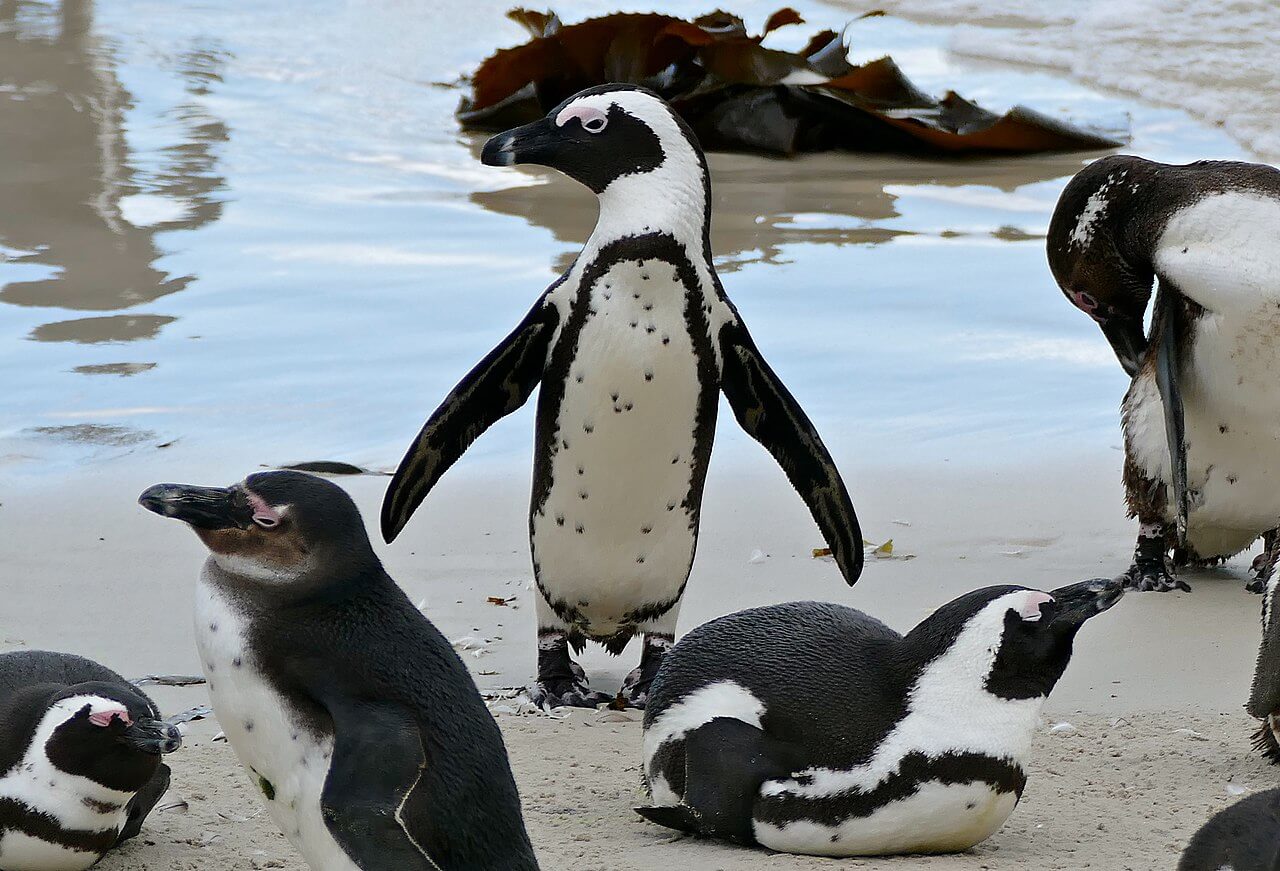
Also known as the Cape penguin or South African penguin, it’s the only species that inhabits the African continent.
It’s 24–28 inches tall and weighs between 4.9 and 7.7 pounds. It’s black on the back and white with black on the chest and belly region. It also has a white band around the eye and a black band in the shape of a horseshoe on the chest.
It’s one of the penguin species classified as “endangered” on the IUCN red list since 2010. The cause is the rapid decline of its population since the end of the 19th century. Among its threats are the following:
- Pollution
- Human disturbance
- Diseases, such as bird flu
- Commercial fishing and climate change, which influence their prey
7. Emperor penguin (Aptenodytes forsteri)
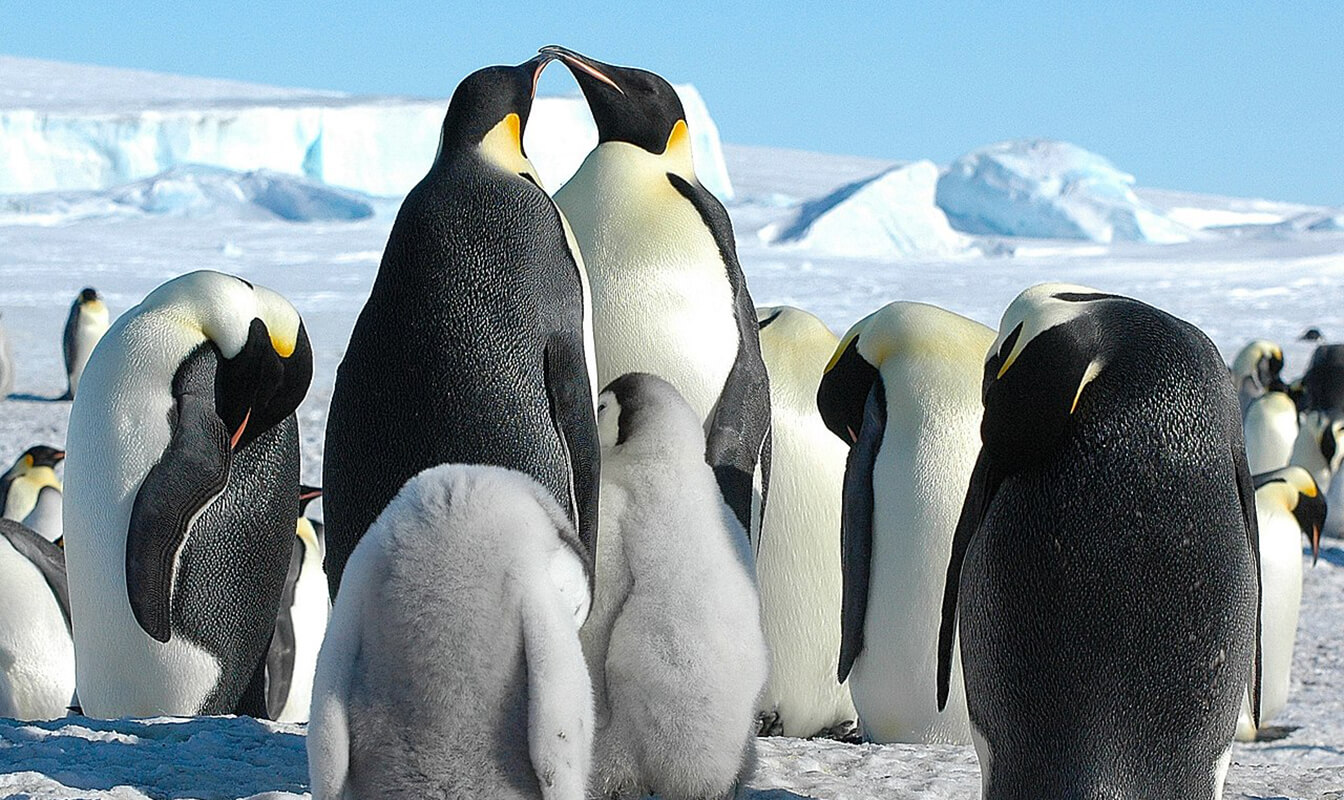
This is one of the most iconic species and the largest seabirds in Antarctica. In fact, they can reach an average of 45 inches in height, 35 inches in wingspan, and 50 to 100 pounds in weight.
They’re characterized by exhibiting black color on the following body parts:
- Wings
- Back
- Head
- Chin
- Back
- Throat
At the same time, the underparts or ventral parts are white. In addition, they have patches of orange-yellow coloration in the auricular area, as well as on the head and chest.
The IUCN has listed them as a “near threatened” species since 2012. This is mainly due to climate change and the current decrease in the concentration, thickness, and duration of the Antarctic ice sheet, which directly affects their reproduction.
Penguin species are endangered due to climate change and human activity
As you can see, most penguins are in danger of extinction or close to this category, according to the IUCN Red List. You’ve already met 7 of them in this article, most of them being threatened by climate change and human disturbance. To contribute to their preservation, we invite you to continue to learn more about these emblematic birds and their conservation status.
Sphenisciformes are emblematic birds distributed in the southern hemisphere. Their wings have been transformed into flippers, so they don’t fly but, rather, they’re adapted to swim and do so excellently. What’s more, their webbed feet help them move around the water very well. But did you know that there are many endangered penguin species?
There are about 19 species worldwide, and more than half of them are threatened by different causes, among them, climate change is the main one. In these lines, we’ll share with you a list of species at risk of extinction, a brief description of each one, and the reasons for their conservation status. Don’t miss it!
Why are there endangered penguin species?

Penguins are threatened by various causes. Almost all species are affected by climate change. This phenomenon has an impact on several key aspects:
- Changes in food availability and abundance.
- Interference in the reproductive success of populations.
- Extension of the sea ice cover (in the last decades, it has decreased).
However, this isn’t the only existing cause. In this regard, we can mention others, such as the following:
- Pollution
- Human disturbances
- Fishing and harvesting of aquatic resources
- Diseases and introduction of new species
Which penguin species are endangered?
According to reports from the International Union for Conservation of Nature (IUCN), nine penguin species are at risk: Five are in the “endangered” category, and four are in the “vulnerable” category. Likewise, two specimens are “near threatened.” Now, let’s get to know some of those that appear in the following list.
1. Southern rockhopper penguin (Eudyptes chrysocome)

The southern rockhopper penguin a robust species, which can reach 21.5 inches in length and about 7.5 pounds in weight. It has white underparts, while the upper parts are slate gray or bluish-black.
It has a bright yellow coloration on the forehead, which extends like a feather on the sides of the head.
It’s been listed as “vulnerable,” according to IUCN reports, since 2008. This is due to the decline of its populations in the past and continuing in recent decades. Threats are varied. The following is a list of the most important ones:
- Fishing.
- Tourism.
- Diseases.
- Land management.
- Oil spills.
- Climate change (as it’s sensitive to ocean temperatures, which affect reproduction and food resources).
2. Macaroni penguin (Eudyptes chrysolophus)

The macaroni species is a large species, measuring 28 inches in length and 11 to 13 pounds in body mass. It has a black coloration on the upper part and white on the lower part. In addition, it has a red beak.
It has crests with the following colors, which are unified in the upper part of the head:
- Black
- Yellow
- Orange
It lives in large colonies of up to 2.5 million individuals, according to the Animal Diversity Web. It’s a sub-Antarctic bird and has been listed as “vulnerable” by the IUCN since 2000 due to various threats. It’s estimated that climate change alters its habitat and affects its reproductive success. It’s also affected by other dangers:
- Fishing
- Diseases
- Pollution
3. Snares penguin (Eudyptes robustus)

This is one of the endangered medium-sized penguins, which can reach an average length of 23.5 inches. Its appearance is similar to that of other Sphenisciformes, with a white ventral region and a dark dorsal region in a blue or black tone.
Among its characteristics, the yellow crest above the eyes stands out. It also has a reddish brown beak, but with a light pink base. This feature differentiates it from its Fiordland penguin (Eudyptes pachyrhynchus).
Its location is restricted to a small group of sub-Antarctic islands, south of New Zealand, the Snares (hence its name). Because of this limited location, they have been listed as “vulnerable” on the IUCN Red List since 1994. In addition, they’re sensitive to the following factors:
- Commercial fishing
- Human activities
- Oil spills
- Oceanographic changes
However, the population remains stable. So says a study published in the New Zealand Journal of Ecology in which the nests of this species were counted over several years (2008, 2010, and 2013).
4. Galapagos penguin (Spheniscus mendiculus)

The Galapagos penguin is a small penguin. In fact, it’s the tiniest member of its genus, reaching 21 inches and weighing 4.4–8.8 lbs. Most of its body is black, although it also has white areas, such as the frontal area.
Its common name refers to its location, as it’s found in the Galapagos Islands. This penguin species has been listed as endangered since 2000 and is threatened by several causes:
- Pollution
- Human disturbance
- Predation by non-native animals
- Climate change and El Niño phenomenon (which causes variations in the food supply)
5. Humboldt penguin (Spheniscus humboldti)

The Humboldt penguin is a bird that measures between 22–28 inches. It’s found from Foca Island (Peru) to Guafo Island (Chile). It has a blackish gray coloration on the dorsal side and white on the ventral side.
It also has a dark head, with a whitish border from the eyes to the chin. It also has – as a distinctive feature – a black band on the chest, which runs from the flanks to the thigh. The base of its beak is light pink.
The IUCN has listed it as “vulnerable” on its red list since 2000. Climate change and the El Niño phenomenon decrease its food availability, affecting its survival. However, these aren’t the only causes involved: Artisanal and industrial fisheries also play a role.
In addition, floods and human presence interfere with their reproductive success. Indeed, tourists have a negative impact on the nests, with trampling and disturbance, as do fishermen and guano collectors. Their threats also include other factors that diminish their populations.
6. The African penguin (Spheniscus demersus)

Also known as the Cape penguin or South African penguin, it’s the only species that inhabits the African continent.
It’s 24–28 inches tall and weighs between 4.9 and 7.7 pounds. It’s black on the back and white with black on the chest and belly region. It also has a white band around the eye and a black band in the shape of a horseshoe on the chest.
It’s one of the penguin species classified as “endangered” on the IUCN red list since 2010. The cause is the rapid decline of its population since the end of the 19th century. Among its threats are the following:
- Pollution
- Human disturbance
- Diseases, such as bird flu
- Commercial fishing and climate change, which influence their prey
7. Emperor penguin (Aptenodytes forsteri)

This is one of the most iconic species and the largest seabirds in Antarctica. In fact, they can reach an average of 45 inches in height, 35 inches in wingspan, and 50 to 100 pounds in weight.
They’re characterized by exhibiting black color on the following body parts:
- Wings
- Back
- Head
- Chin
- Back
- Throat
At the same time, the underparts or ventral parts are white. In addition, they have patches of orange-yellow coloration in the auricular area, as well as on the head and chest.
The IUCN has listed them as a “near threatened” species since 2012. This is mainly due to climate change and the current decrease in the concentration, thickness, and duration of the Antarctic ice sheet, which directly affects their reproduction.
Penguin species are endangered due to climate change and human activity
As you can see, most penguins are in danger of extinction or close to this category, according to the IUCN Red List. You’ve already met 7 of them in this article, most of them being threatened by climate change and human disturbance. To contribute to their preservation, we invite you to continue to learn more about these emblematic birds and their conservation status.
All cited sources were thoroughly reviewed by our team to ensure their quality, reliability, currency, and validity. The bibliography of this article was considered reliable and of academic or scientific accuracy.
- BirdLife International. (2020). Aptenodytes forsteri. The IUCN Red List of Threatened Species 2020: e.T22697752A157658053. https://www.iucnredlist.org/species/22697752/157658053
- BirdLife International. (2020). Eudyptes chrysocome. The IUCN Red List of Threatened Species 2020: e.T22735250A182762377. https://www.iucnredlist.org/species/22735250/182762377
- BirdLife International. (2020). Eudyptes chrysolophus. The IUCN Red List of Threatened Species 2020: e.T22697793A184720991. https://www.iucnredlist.org/species/22697793/184720991
- BirdLife International. (2018). Eudyptes robustus. The IUCN Red List of Threatened Species 2018: e.T22697782A132602343. https://www.iucnredlist.org/species/22697782/132602343
- BirdLife International. (2020). Spheniscus demersus. The IUCN Red List of Threatened Species 2020: e.T22697810A157423361. https://www.iucnredlist.org/species/22697810/157423361
- BirdLife International. (2020). Spheniscus humboldti. The IUCN Red List of Threatened Species 2020: e.T22697817A182714418. https://www.iucnredlist.org/species/22697817/182714418
- BirdLife Internacional. (2020). Spheniscus mendiculus. The IUCN Red List of Threatened Species 2020: e.T22697825A182729677. https://www.iucnredlist.org/species/22697825/182729677
- Fisher-Hewett, A. (2021). Eudyptes robustus. Animal Diversity Web. Consultado el 02 de julio de 2023. https://animaldiversity.org/accounts/Eudyptes_robustus/
- Hiscock, J., & Chilvers, L. (2016). Snares crested penguins Eudyptes robustus population estimates 2000–2013. New Zealand Journal of Ecology, 40(1), 108-113. https://www.jstor.org/stable/26198739
- Molini, U., Aikukutu, G., Roux, J. P., Kemper, J., Ntahonshikira, C., Marruchella, G., Khaiseb, S., Cattoli, G., & Dundon, W. G. (2020). Avian Influenza H5N8 Outbreak in African Penguins (Spheniscus demersus), Namibia, 2019. Journal of wildlife diseases, 56(1), 214–218. https://pubmed.ncbi.nlm.nih.gov/31483707/
- Nissley, H. (2015). Spheniscus humboldti. Animal Diversity Web. Consultado el 02 de julio de 2023. https://animaldiversity.org/accounts/Spheniscus_humboldti/
- Pearce, W. (2011). Spheniscus demersus. Animal Diversity Web. Consultado el 02 de Julio de 2023. https://animaldiversity.org/accounts/Spheniscus_demersus/
- Phelan, D. (1999). Eudyptes chrysocome. Animal Diversity Web. Consultado el 02 de Julio de 2023. https://animaldiversity.org/accounts/Eudyptes_chrysocome/
- Reynolds, K. (2001). Eudyptes chrysolophus. Animal Diversity Web. Consultado el 02 de julio de 2023. https://animaldiversity.org/accounts/Eudyptes_chrysolophus/
- Wilber, S. (2020). Aptenodytes forsteri. Animal Diversity Web. Consultado el 02 de julio de 2023. https://animaldiversity.org/accounts/Aptenodytes_forsteri/
This text is provided for informational purposes only and does not replace consultation with a professional. If in doubt, consult your specialist.








